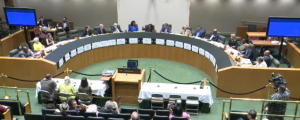
By Joe Farkus, NDG Contributing Writer
The Dallas Mayor’s Task Force on Confederate Monuments met for their second meeting at City Hall Thursday, Sept. 7 – the first of two meetings open to public comment. The meeting was sparsely attended by members of the public, with less than a dozen people speaking to the task force on the subject – both for and against removing Confederate statues and renaming streets and parks named after Confederate soldiers.
“Does moving a statue really eradicate racism?” one woman asked the members of the task force during the portion open to public comment. “I don’t think so, because I don’t think there’s a shred of evidence that Robert E. Lee was a racist,” she added.
The Office of Cultural Affairs – which presented the historical circumstances surrounding the erection of specific Confederate monuments to the task force – later appeared to rebuff the speaker’s claim, stating there was a “mythology” that emerged after the Civil War regarding Lee’s life. The Cultural Affairs spokesperson went on to dispute the claim Lee never owned slaves and that his writings never expressed his views on race, citing an Atlantic Monthly article for supporting evidence.
The speaker went on to allege that no body of government is charged with “moral authority”, questioning the basis for the task force’s mission.
“We are not here to destroy history,” Chair Frances Waters later stated in an attempt to clarify and restate the task force’s purpose. “We are deciding what historical monuments need to remain in the public square, which need to be moved someplace else, and what to do with them.”
The clarification proved to be effective, as the task force held its first two votes on its recommendations – with a vote to rename Lee Park (allowing the name of the park to revert back to its original name – Oak Lawn Park) and a vote in favor of renaming the Confederate Cemetery in South Dallas.
There was also some concern expressed over the Dallas City Council’s Sept. 6 vote to immediately remove the Robert E. Lee statue in Lee Park; a task that – as of Friday – has yet to be completed despite a judge lifting the temporary injunction which halted progress on removing the statute on Wednesday afternoon.
“That was not the right way to do business,” said task force member Bryce Weigand. “The crane was out there right after the vote was taken. That’s not a democracy; it is not a way to do business.”
The next task force meeting on Friday, Sept. 15 will review possible options for where to store the Lee statue once it is successfully removed as well as decisions regarding the renaming of streets named after Confederate soldiers.





The American Civil War began on April 12-14, 1861 with the Battle of Fort Sumter.
In the following year, 53 battles were fought in 12 different states. The most significant battle occurred on April 6-7, 1862 – the Battle of Shiloh in Tennessee.
Those who state or imply that the war was fought to free the slaves have an indisputable fact of history with which to contend.
It wasn’t until April 16, 1862, after a year of soldiers dead, wounded and missing on both sides, including the bloody Battle of Shiloh, that President Abraham Lincoln signed into law legislation (passed by the House on April 3, 1862) entitled: “An Act for the release for the release of certain persons held to service or labor in the District of Columbia.” It freed about 3,000 women, men and children who were enslaved in 1862 until a year after the war began. (AKA: The DC Compensated Emancipation Act)
So, for the first full year of the war, for what aim were Union soldiers fighting? To end slavery?